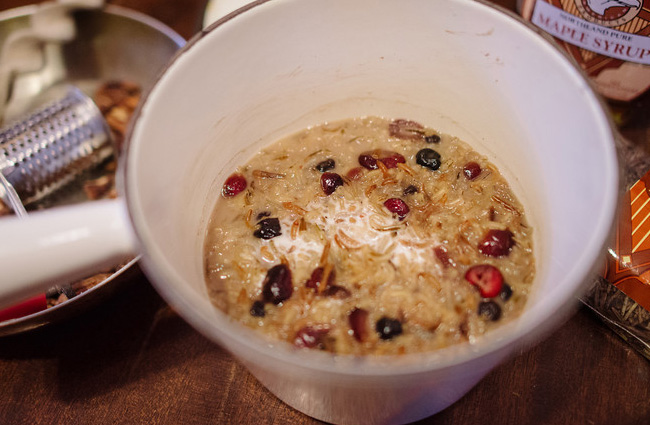
I race from my car, darting through the prickly embrace of a four-degrees-below-zero morning and into the toasty confines of Birchbark Books. Minnesota Book Award-winning author and poet Heid Erdrich is already there with a steaming pot of manoomin porridge.
“This is not even the best version,” she claims, humbly. “It didn’t even have time to set up.” It’s nutty, creamy, and dense. The wild rice is cooked until it’s bursting but still toothsome, with wild blueberries (frozen, from Costco), Craisins, pecans, and a distinct sweetness from shaved maple sugar. My hands begin to unthaw around the bowl as the porridge warms me from the inside out. I look out at the frost speckling my car windows and consider inhaling the entire pot (recipe below).
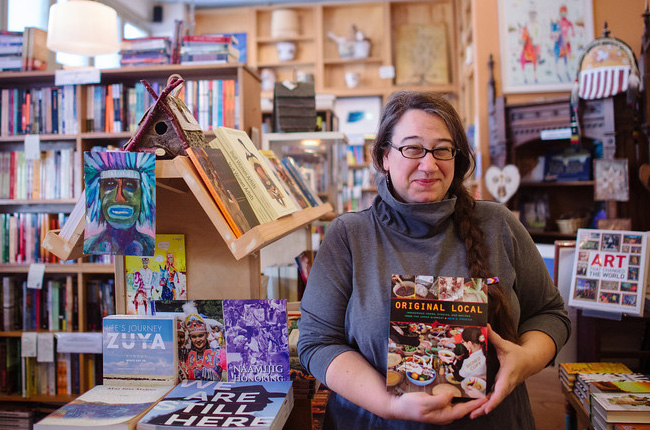
The dish is artfully simple and relies on just a couple key ingredients. Recipes like this one abound in her new book, Original Local: Indigenous Foods, Stories, and Recipes from the Upper Midwest ($19.95, MHS Press). As with all good food writing, the food itself is not really the story. Erdrich’s is a functional cookbook, but its strength is a patchwork of stories, recollections, and traditions from people sharing their personal connections to indigenous ingredients.
“The conversation around local food in the upper Midwest is so big, and it doesn’t address the fact that these foods were stewarded, produced, developed, and protected by indigenous people,” says Erdrich. “Because there’s so much food inequity, it seemed like it was time to talk about where these foods come from, who’s taking care of them, and what they mean to people here.”
The book is a celebration of ingredients, beginning with a comprehensive exploration of hand-harvested wild rice, or what the Anishinaabe people would call manoomin.
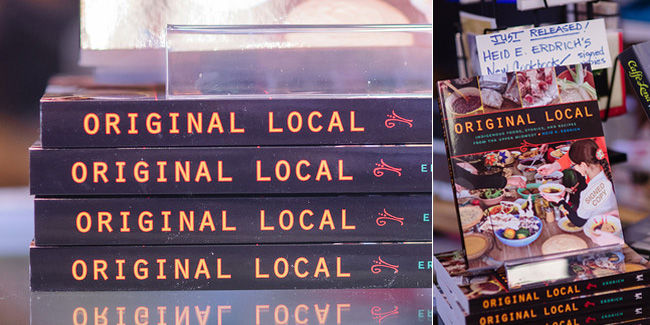
“Real manoomin is a wild grass that takes a long time to grow,” Erdrich tells us. “It grew widely, everywhere in the United States. Now it’s pretty much only in the upper Midwest. It’s genetically diverse in each body of water. It cooks quickly. It’s not that hard black stuff – that cultivated rice that somehow manages to be called wild rice though there’s nothing wild about it. The tastes range from astringent and grassy to smoky and nutty.” Real manoomin is also expensive – if you can find it for better than $9/lb. (at realwildrice.com), leave a comment below.
Erdrich is a poet after all, and the vignettes between the recipes feel almost lyrical. So while very much a cookbook, Original Local doesn’t feel formulaic. The stories are wide ranging, from her family and tribal members to chefs and scientists. They’re a good mix of breezy and heartfelt, funny and wistful, and act as quick aperitifs to whet the appetite before you choose a dish to try out.
You can join her tonight for a reading at Double Hungry: Sustainable Poems, at 7:30pm at Black Dog Coffee in Lowertown St. Paul. She will be hosting poets G. E. Patterson, James Autio, and Kristin Naca, and the cafe will offer some specials taken straight from the book.
THE HEAVY TABLE: For a native of the Upper Midwest before contact with Europeans, what would a normal day of eating look like?
HEID ERDRICH: It’s going to be micro-local. Someone up on the edge of Lake Superior would eat mostly turkey and a grain kind of like quinoa. They’d grind it into cakes, from the plant that’s called lamb’s quarters. In another place, you might have wild rice and smoked fish. Everyone ate berries, as a seasoning and as food. In North Dakota, you’d have beans and corn for a lot of the year, sunflowers and sunflower oil. Some places, people ate nothing but corn and venison. In parts of Michigan there were even caribou.
HT: Do you have a personal food memory that really stands out in your mind?
HE: There are a lot of them. You privilege one when you pick it. I suppose watching my mom sieve cranberries. The color of those cranberries was just so vivid, literally, in my mind. Also picking wild plums. It just seems like they’re glowing, because they’re really yellow inside, and just a little pink under the skin. And the skin is frosty, so they’re an odd pink-yellow color, just beautiful. I just remember eating way too many of them and getting a stomachache.
HT: The recipes in the book seem more, let’s say, reverent of indigenous traditions rather than being 100% authentic.
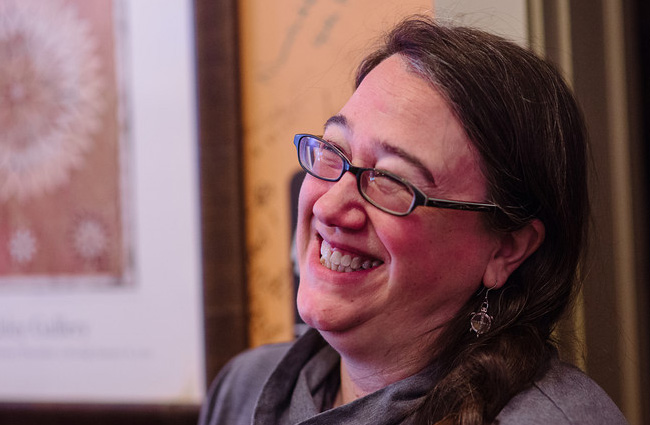
HE: Indigenous people are plagued by the notion of the “authentic.” I mean, what is really authentic in any culture? It’s always shifting its dynamic. I love cookbooks that are more historical, but I cook those recipes and find them lacking. There are things that just appeal to our contemporary tastes. I wanted to shift it a little, and feature an ingredient but not be a slave to only indigenous things. To me, that just felt natural.
HT: It seems like you learned a fair amount about your own family’s own food traditions with this research.
HE: One of my favorite things was talking to my dad about why he harvested wild rice one year and only that one year. And he told me of, 45 years ago, harvesting this wild rice, and then my mom comes out of the basement with a jar of it! It’s still perfectly usable but looks nothing like any wild rice I’d ever seen. It’s a very particular plant, I just got so interested in that. I found research from old trade journalists saying that the area I grew up in is said to be the origin of wild rice. And I had this 45-year-old rice that could be part of the original stock.
HT: Name a rarely used indigenous ingredient that you think people should eat more often.
HE: Sumac! It’s a great seasoning or you can make drinks from it – Indian Kool-Aid, they call it. We used it on all sorts of things. I love it on popcorn. I say in the book to make a seasoning from sumac and maple sugar, put it in a shaker, and use it on everything. You can get maple sugar at the co-ops.
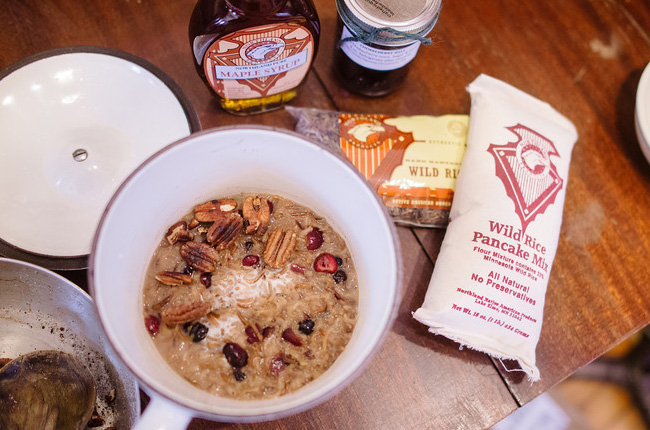
Maple sugar was the secret ingredient in the porridge, which Erdrich used in lieu of maple syrup. “Whenever I make something and people say they really like it, but can’t explain why, usually, it’s the maple sugar,” she beams.
Manoomin Porridge In Coconut Milk
Serves 6 | Commodity foods, though relics of a system that kept American Indian people dependent on the federal government, are still fondly recalled by many whose memories of their grandmas making cheese sandwiches off a huge rectangular block are a comfort that has lasted. I loved canned milk that we used on cereal — hot bowls of farina (also a commodity item) — and that we mixed with water to make drinking milk from time to time. Our usual fare was nonfat dry milk, or blue water, as we thought of it, so canned milk was creamy-dreamy to us.
While this recipe is more wholesome and satisfying than any of the hot mush cereals we ate as kids, it reminds me of school days and the kindness of my elders making me a steaming bowl upon which I poured canned milk. I’ve replaced the cow’s milk with coconut milk to make a nondairy treat that even my kids will eat.
2 cups cooked manoomin
1 (14-ounce) can unsweetened coconut milk, shaken, or evaporated milk, ½ cup reserved
½ teaspoon ground allspice or cinnamon
⅛ teaspoon salt
1 teaspoon vanilla extract, or 1 vanilla bean, split, seeds scraped into milk
¼ cup maple syrup
¼ cup chopped dried blueberries and cranberries
¼ cup hazelnuts, butternuts, walnuts, or pecans, toasted
In a medium saucepan, combine cooked manoomin, coconut or evaporated milk, allspice or cinnamon, salt, and vanilla. Over medium-high heat, simmer until rice begins to puff open and porridge begins to thicken; remove from heat. Stir in maple syrup and berries. Serve into bowls and top with nuts and reserved milk. Porridge will thicken when cooled and is excellent reheated with additional fresh or frozen fruit. It can be served as a dessert.
(Recipe courtesy of the Minnesota Historical Society Press)
